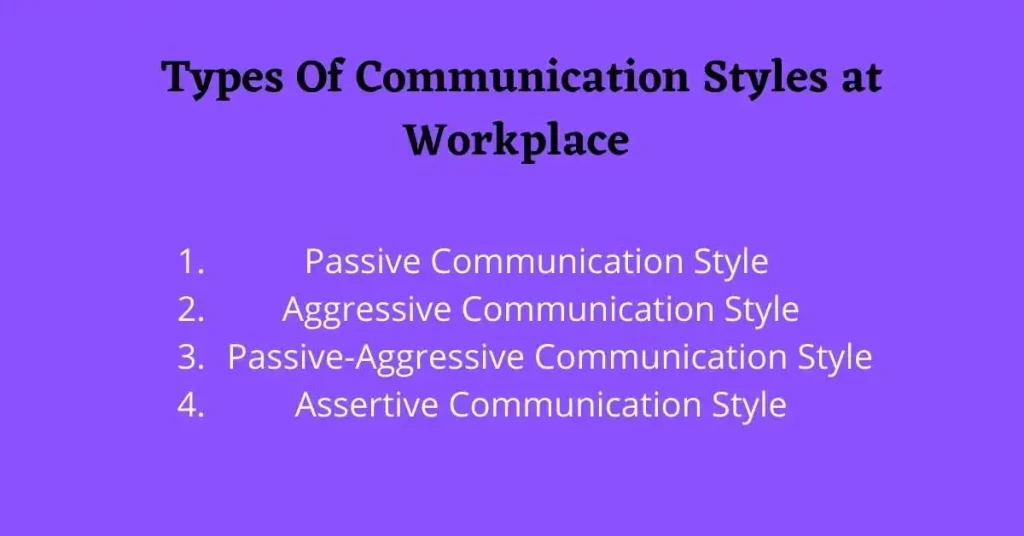Communicating Styles At Work – Types And How To Use Them
Communicating Styles At Work – Types And How To Use Them
Effective communication in the workplace is key to business success. Many industries have recently shifted to mostly virtual work, affecting how workplace communication and function are performed.
Conversations at work are not the only means of communication. Different types of information are exchanged by using different methods. Employees and corporations alike benefit from communication, whether formal or informal.
As per the Workforce poll, “Approximately 60% of companies lack long-term communication strategies for their internal communication.” A review and update of communication strategies will be helpful in determining the direction and focus of ideas that should be shared for the benefit of the organization.
It is, therefore, crucial to understand the various forms of communication in the workplace in order to ensure the success of your business. But, before that let’s understand what workplace communication is and why it is important.
Communication at Work: What is it and How Important is it?
The concept of workplace communication refers to how employees exchange information and ideas within an organization. Either in person or virtually, communication is essential to achieving organizational objectives and accomplishing tasks.
Around 70% of full-time workers worked from home at some point during the COVID-19 pandemic. During that time, businesses and international communications were disrupted.
In spite of the availability of vaccines that now allow some industries to return to in-person activity, the hybrid workforce trend is here to stay and it is not going anywhere soon. Companies must prioritize managing virtual workplace communications more than ever.
It is crucial that the context of an idea, statement, or question be present for effective communication to take place. Effective communication requires the presence of a context and the right medium for the communications.
Therefore, it is important to establish effective communication. Tools such as Slack, Zoom, and Microsoft Team streamline communication across organizations, teams, and individuals.
What are the Different Types of Communication in the Workplace?
The various ways people communicate with each other are called styles of communication. Communication styles are not limited to verbal communication but also include nonverbal communication. They reflect individual personalities and characteristics just as our outward appearance reflects our inner makeup.
Understanding how to communicate effectively with other co-workers will dramatically improve your relationships. Communication styles at work generally fall into four categories: Passive, Passive-Aggressive, Aggressive, and Assertive.

1. Passive Communication Style
The passive communicator prefers to keep a low profile and ignore the attention of others. They rarely assert themselves or take a strong stance during debates. It can be difficult for them to communicate their discomfort or need for help with an important project.
Coworkers are unable to understand what their passive communicator employees are feeling since they do not express what concerns them. They tend to avoid expressing their feelings and thoughts.

Apart from this, some of the tendencies to identify Passive Communicators are:
- Quiet
- Being unable to say NO
- Poor postural alignment
- Having an easy-going attitude
- Keep Opinions to themselves
- Avoid Conflict
- Inability to make eye contact
- Have a soft voice
- Do not complain a lot
- Fidgeting
- Apologetic Behavior
The common phrase a Passive Communicator would use are:
- “I just want to keep the peace.”
- “It does not matter that much.”
How to Work With Passive Communicators?
You can encourage a good working relationship if the other person is a passive communicator by using these methods:
- Go straight to the point. Start one-on-one conversations as a passive communicator tends to be more comfortable in private than in group settings.
- Ask for their opinions. Let them think about their thoughts for a while before responding.
- Ask open-ended questions. Never use yes or any questions that can be answered by simply saying yes or no. Be patient when passive individuals take their time to analyze their responses.
And, If you’re a Passive Communicator,
- Do your best to improve your communication skills.
- Don’t be afraid to speak up when the opportunity arises.
- Avoid group settings if you feel uncomfortable, and arrange private meetings.
- Consider using email instead of in-person communication if you prefer writing over speaking.
2. Aggressive Communication Style
Communicators who exhibit aggressive behavior might act before they think, which can negatively impact relationships and hinder performance. You can identify aggressive communicators by their frequent expressions of thoughts and feelings. Usually, they are very opinionated.
Their opinion is never to be censored, even if it hurts another person’s feelings. They tend to be demanding and loud, and usually blame others for their mistakes. Then they demand respect from others by asking rude questions.

If controlled properly, however, this style of communication can often lead to great leadership because it can get people to follow them.
Apart from this, some of the tendencies to identify Aggressive Communicators are:
- Interrupting others while they are speaking
- Intense eye contact
- Harsh Tonality
- Mocking behavior
- Invading personal spaces
- Using aggressive gestures like crossed arms
- Always advocation personal opinions
- Very confrontational
Common phrases an Aggressive Communicator would use are:
- “I am right and you are wrong.”
- “It’s all your fault.”
- “I will get my way no matter what.”
How to Work With Aggressive Communicators?
You can encourage a good working relationship if the other person is an aggressive communicator by using these methods:
- Be calm and assertive. Rather than being intimidated by aggressive communications, remain calm and assertive. Talk about actionable ways to resolve the problem.
- Keep conversations professional. Avoid bringing your personal feelings into the conversation.
- Take a step back. If the aggressive communicator becomes too demanding or if progress no longer appears to be being made.
And, If you’re an Aggressive Communicator,
- Consider learning positive communication techniques to overcome them.
- Keeping your life stress-free can also help you to overcome your aggressive tendencies.
- Actively managing stress through physical activity and mindfulness or meditation is a healthy method of coping with stress.
3. Passive-Aggressive Communication Style
Communicators who are passive-aggressive fall somewhere between passive and aggressive. However, they are not as impervious to passive communication as passive communicators. They convey their feelings in a subtler way through muttering or indirect communication, rather than by outright statements.
A passive-aggressive communicator may act in a way that is not in sync with the way they speak, and in this regard, they can manipulate the situations that benefit them.

Apart from this, some of the tendencies to identify Passive-Aggressive Communicators are:
- Giving happy facial expressions when they are clearly sad
- Providing the silent treatment
- Mumming
- Using sarcasm
- Exhibiting denial
Common phrases a Passive-Aggressive Communicator would use are:
- “I don’t mind that, but don’t be surprised if others do.”
- “Sure, we can implement your plan.” (Then they murmur, “Your stupid plan.”)
How to Work With Passive-Aggressive Communicators?
Using these methods you can establish a good working relationship with a passive-aggressive communicator:
- Be clear and concise. Don’t confuse or misinterpret your requests.
- Face negative behavior head-on. If the situation doesn’t change, talk about it with your manager.
- Directly ask for feedback. Seek to elicit honest feedback from them in one-on-one situations.
And, If you’re a Passive-Aggressive Communicator,
- Be open to communicating your thoughts and needs.
- Be sure that you communicate clearly and honestly so that you feel heard and that you can take direct action.
4. Assertive Communication Style
Communicating assertively at work is typically the most effective and respectful style. The most assertive communicators always keep their words respectful and polite while expressing their ideas. They tend to use a lot of “I” statements to establish trust and rapport.
When they share their feelings they make sure the other person is not insulted or unwelcomed; they don’t make the other person feel belittled or unwelcomed. They share ideas, thoughts, and emotions while also taking into account the other’s needs.

Assertive communicators strive to find a solution that appears to have a “win-win” situation for all parties involved.
Apart from this, some of the tendencies to identify Assertive Communicators are:
- Friendly nature
- Good eye contact
- Good posture
- A clear voice
- Bold and humble personality
- Expansive gestures
- Listen to others
- Healthy expression of emotional and intellectual
Common phrases an Assertive Communicator would use are:
- “I think this is the best way to proceed, but I would like to hear what you think.”
How to Work With Assertive Communicators?
You can encourage a good working relationship if the other person is an assertive communicator by using these methods:
- Make clear your thoughts. Express your idea and thoughts in a way that they find interesting.
- Be open to asking for suggestions/advice. Assertive communicators tend to be bold yet also humble, so feel free to ask them any questions you might have.
And, If you’re an Assertive Communicator on your team,
- Motivates your teammates to share their ideas and thoughts
- Give them leadership roles
- Help them deal with passive communication styles, passive-aggressive communication styles, and aggressive communication styles.
What Do You Mean by the 3C’s of Assertive Communicators?
- Confidence: You trust yourself and your ability to handle a difficult situation.
- Clear: What you want to convey is clear and understandable.
- Controlled manner: You deliver information calmly and in a controlled manner.
How Can Effective Communication Style Increase Your Productivity?
A positive work environment can be largely attributed to effective communication at work because it can increase employee productivity and overall morale and retention. Effective communication leads to increased productivity. They both go hand in hand.
The following factors can increase company productivity through effective workplace communication:
1. Less Friction and Misunderstanding
When information is not effectively communicated, there is the possibility of miscommunication and misunderstanding. Lack of communication leads to confusion at work. Thus, transparency and effective communication among workers will reduce friction at work.
2. Ensure Better Collaboration and Teamwork
Collaboration and teamwork can be enhanced through effective communication. Through effective communication, employees may also be able to come up with unique ideas and solve problems together.
The hybrid work culture is growing now, and some organizations are finding it difficult to integrate remote as well as in-office employees, causing communication and trust issues. However, incorporating productivity apps in the workplace can eliminate such issues.
Some of the productive apps in a workplace are:
- timeTracko – Best For Employee Productivity and Monitoring Software
- When I Work – Best Software For Teams Of All Sizes
- Toggl Track- Best Time Tracking Pomodoro App
Learn more: Importance of Team Collaboration in the Workplace
3. Increased Accountability
Effective communication enables employees to act in accordance with their responsibilities because they can gain clear and definite instructions. The workplace becomes more productive when accountability is improved.
FAQs
1. What are the methods of communication in the workplace?
A person communicates in five ways at the workplace: verbally, non-verbally, in writing, visually, and as a listener.
2. Why is communication important in a workplace?
The importance of communication in the workplace is that it fosters trust and contributes to employee commitment. The smooth operation and productivity of a company are directly related to communications at the workplace.
3. How does personality affect communication in the workplace?
Communicating preferences and evaluating information are influenced by our personality types. Therefore, it is important to understand our own communication styles and the styles of those we work with in order to serve effectively as leaders, team members, and collaborators.
4. What are communication style examples?
A person’s communication style can be classified into four different categories: passive, aggressive, passive-aggressive, and assertive. Each person communicates differently as a result. That’s why understanding how each style differs helps in understanding how they should be handled.
Conclusion
By learning more about your employees’ communication style, you can build a more cohesive team, which in turn helps to create a more positive work environment.
Better work environments will, of course, lead to more productive and engaged employees and more profitable businesses. And, who does not want that?

 in Melbourne
in Melbourne 
 Employee Screen Monitoring Software
Employee Screen Monitoring Software App and Website Monitoring Software
App and Website Monitoring Software Time and Attendance Software
Time and Attendance Software Finance
Finance Banking
Banking Healthcare
Healthcare Lawyers
Lawyers Retail & ecommerce
Retail & ecommerce Knowledge base
Knowledge base Blogs
Blogs Installation Guide
Installation Guide FAQs
FAQs About
About Media Kit
Media Kit Contact us
Contact us